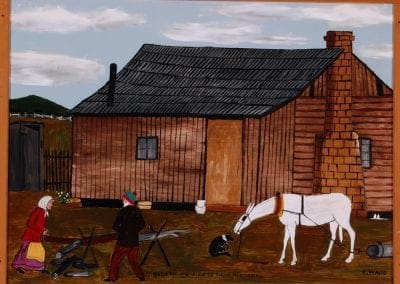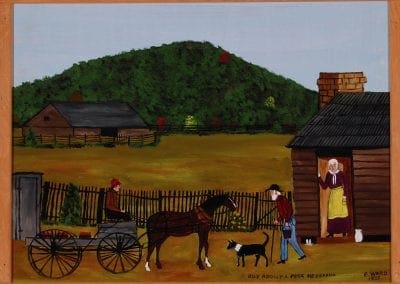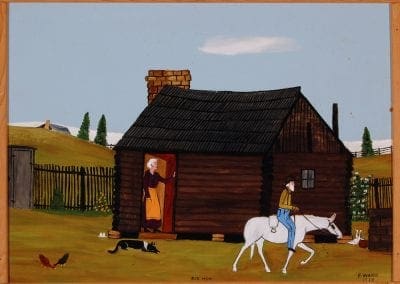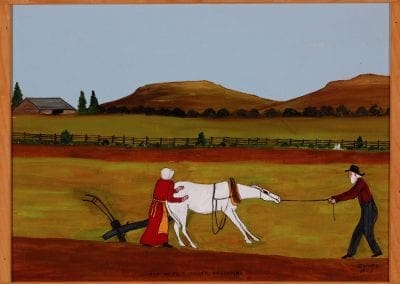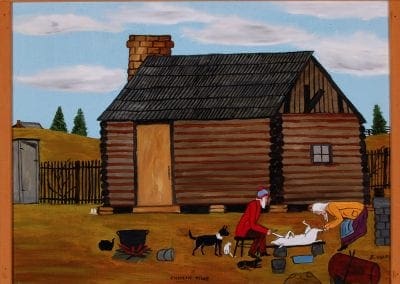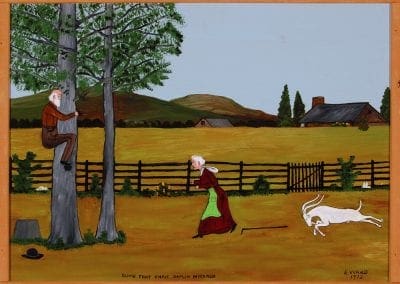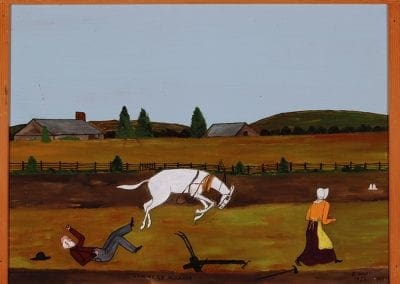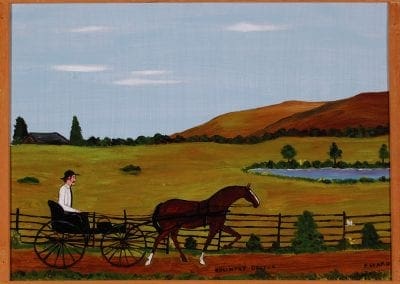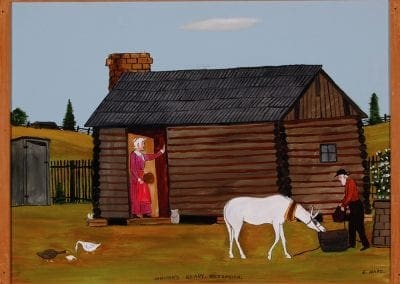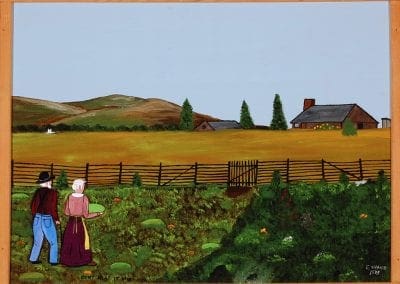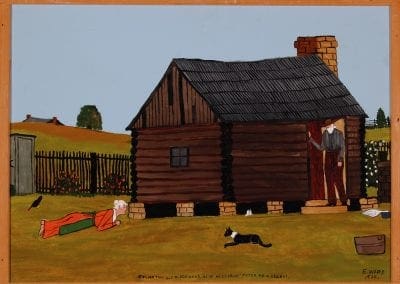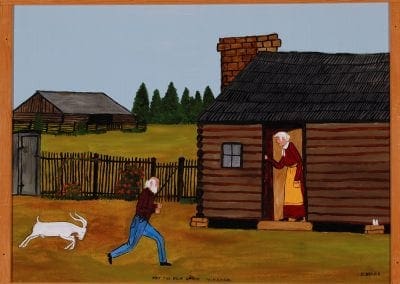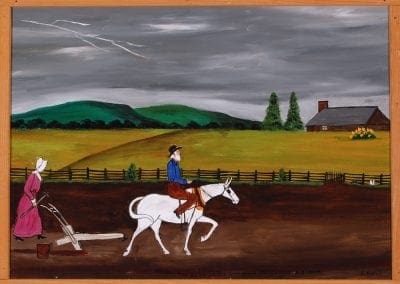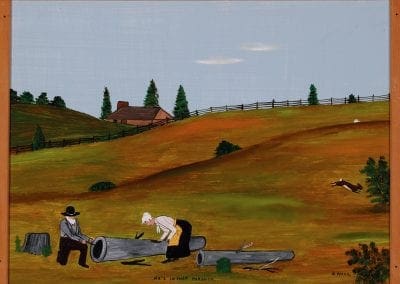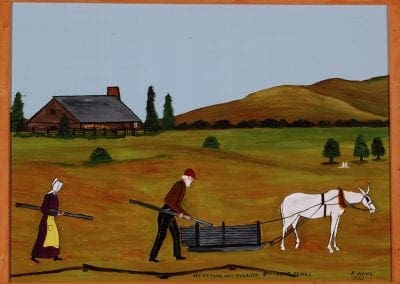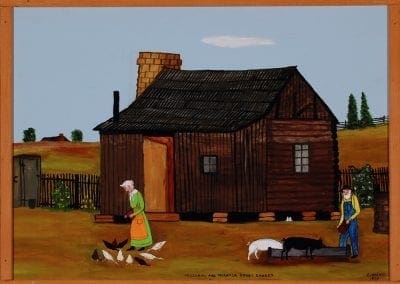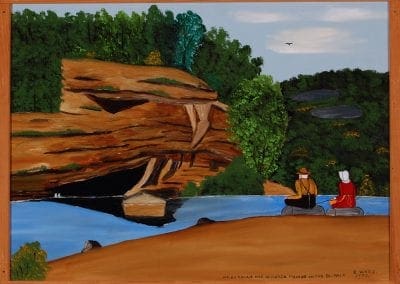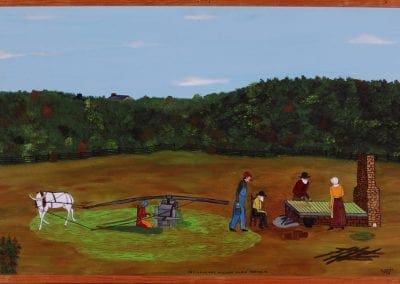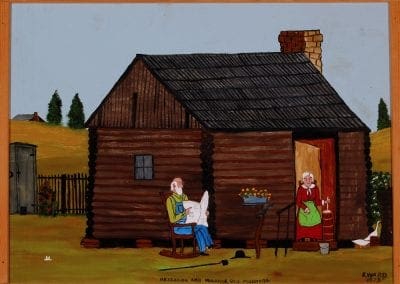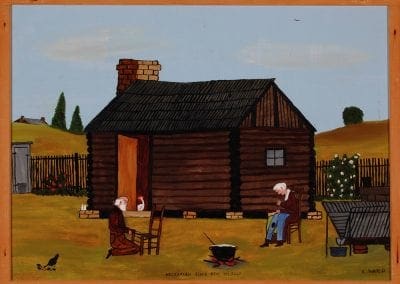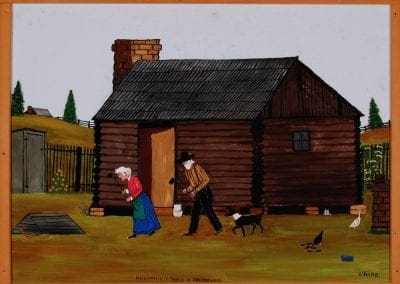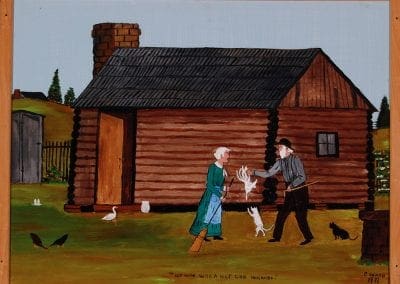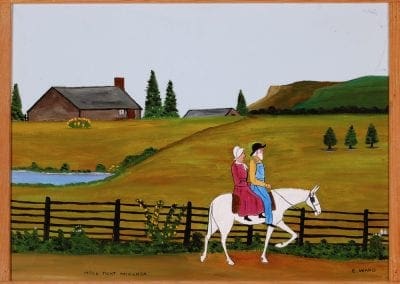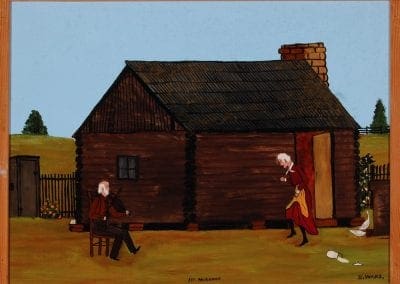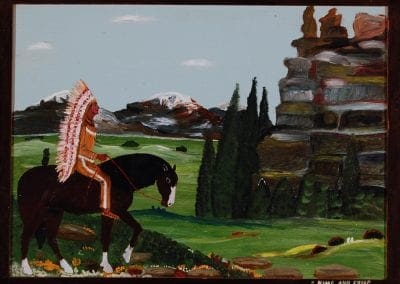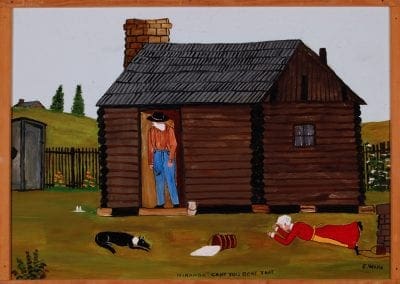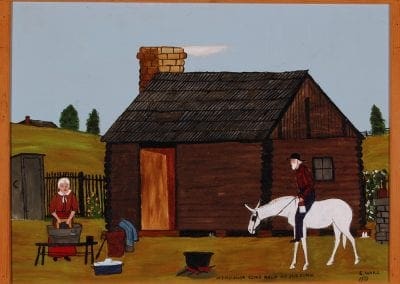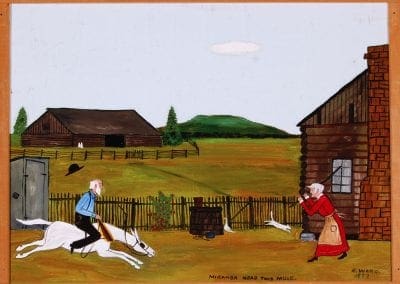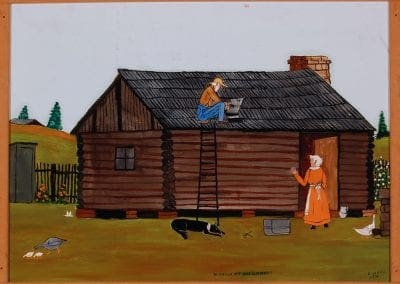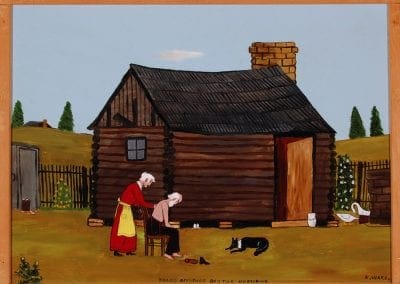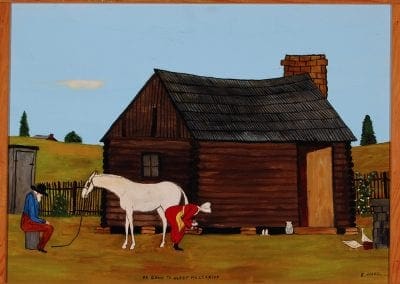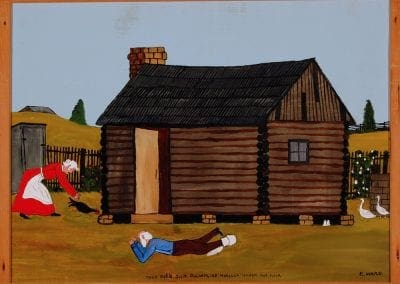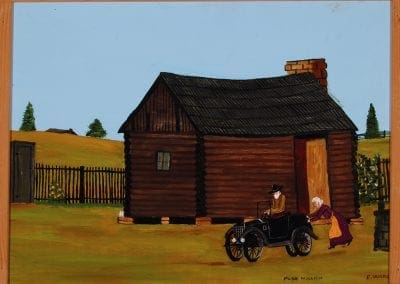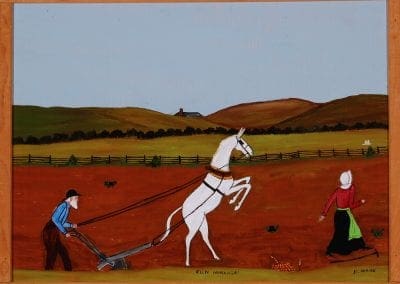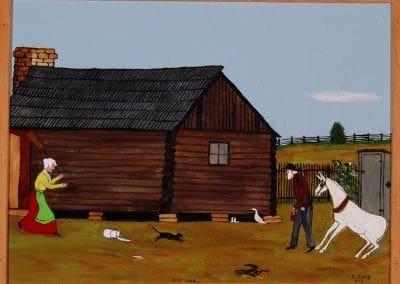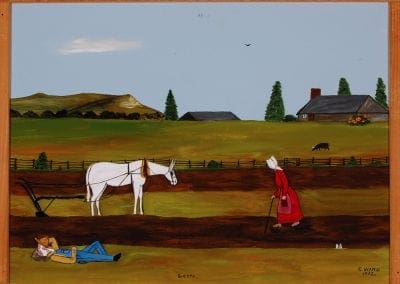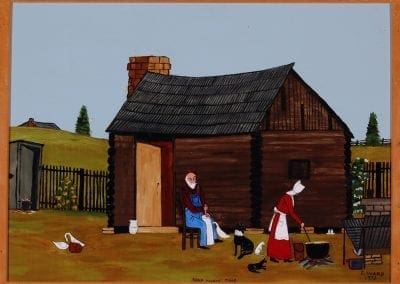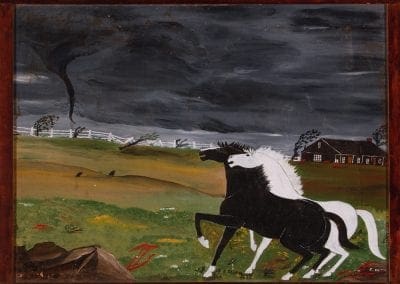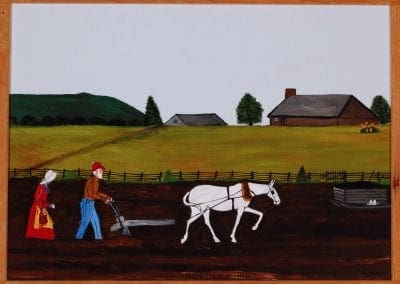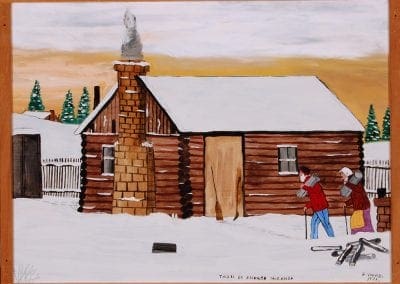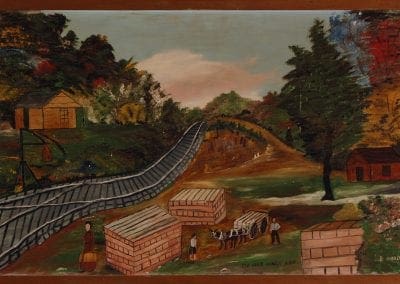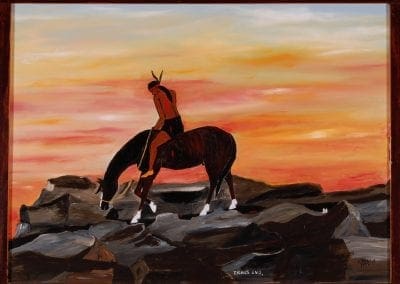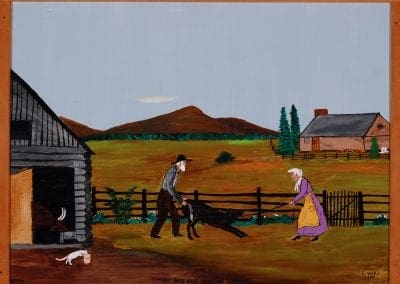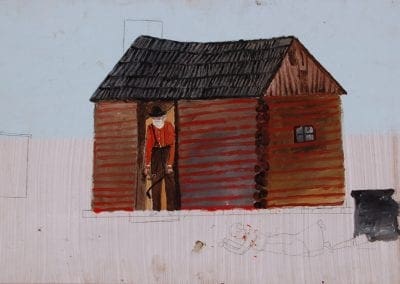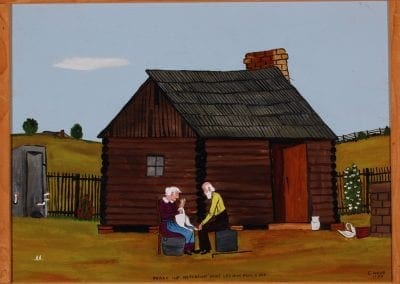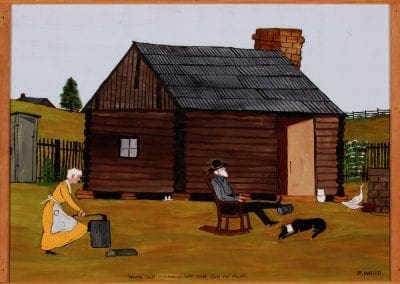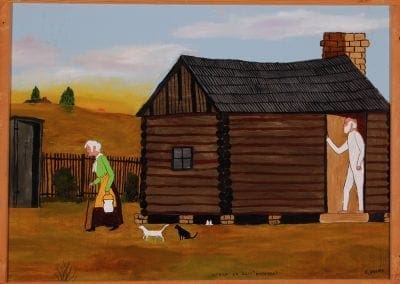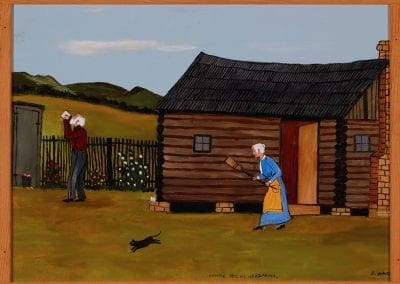"A Real Satisfaction"
Online Exhibit
Essie Ward at her home near Marshall (Searcy County), Arkansas, 1970s. Jeanne Hofer-Tucker Collection (S-96-10-3)
Folk artist Essie Treat Ward has been called the “Grandma Moses of the Ozarks.” Born in the Searcy County community of Nubbin Hill in 1902, Essie began drawing when she was a young girl. Throughout her life, she created drawings, paintings, toys, and sculptures—all without the benefit of formal training.
Hers was the life of a traditional Ozark woman. Essie married Jesse Ward in 1922. The couple raised chickens, hogs, vegetables, fruit trees, and seven children on a small farm near Marshall. Much of the farm work fell to Essie when Jesse was diagnosed with diabetes.
In 1959, Essie was diagnosed with cancer. After an operation, doctors sent her home with orders to slow down. That’s when Essie put down the plow and picked up a paint brush.
Most of Essie Ward’s paintings show the adventures of Miranda and Hezzakiah, an old Ozark pioneer couple. Essie was inspired to create these characters when a friend came to her with a photograph of a woman churning butter in the doorway of a log cabin. “He had carried that picture in his billfold for thirty years trying to find somebody to paint it,” Ward said. She tried her hand at it, and as she recalled, “it turned out real good.”
Miranda and Hezzakiah find themselves in all sorts of predicaments. They are joined by a cast of characters, including farm animals, wildlife, and even ticks. The Miranda and Hezzakiah paintings became so popular that orders came in faster than Ward could fill them. She painted on masonite, holding the board in her lap, with oil paints straight from the tube. She usually finished one picture a day.
Although each painting is original, Ward developed a series of fifty-five different Miranda and Hezzakiah scenes, complete with landscapes shaded correctly for the season of the year. Customers selected one of the scenes when they placed their order. Ward’s trademark appears in every painting: two tiny white marks that resemble rabbit or mule ears.
Fame came to Essie Ward in 1970, when she was invited to participate in the Smithsonian’s Festival of American Folklife in Washington, D.C.
Through the years, Essie Ward sold hundreds of paintings. In a 1971 interview she remarked, “[Painting] is all I’ve ever wanted to do, yet I never studied anything about painting. I guess you could say I just paint as I see it—actually, or in my memory. Others like what I do. That’s a real satisfaction.”
Essie Ward lived all of her seventy-nine years in the hills of Searcy County. She died in 1981, and is buried at Canaan Cemetery in Marshall.
To learn more about the life and work of Essie Ward, watch a vidcast by Shiloh Museum outreach coordinator Susan Young (also available on YouTube and iTunes).
We often receive questions from folks asking us to estimate the monetary value of their Essie Ward painting. As a matter of best museum practices, the Shiloh Museum does not provide or estimate values for any antiques or collectibles. Regarding Essie Ward, some years back we checked with a qualified folk art appraiser and he reported that Essie Ward paintings “have no presence in the folk art market and therefore no estimated market value.” If you are interested in contacting an art appraiser about your painting(s), qualified folk art appraisers can be found at the American Society of Appraisers website. Under “Appraisal Expertise/ASA Specialty, select “American Folk Art.”

Essie Ward at her home near Marshall (Searcy County), Arkansas, 1970s. Jeanne Hofer-Tucker Collection (S-96-10-3)
Folk artist Essie Treat Ward has been called the “Grandma Moses of the Ozarks.” Born in the Searcy County community of Nubbin Hill in 1902, Essie began drawing when she was a young girl. Throughout her life, she created drawings, paintings, toys, and sculptures—all without the benefit of formal training.
Hers was the life of a traditional Ozark woman. Essie married Jesse Ward in 1922. The couple raised chickens, hogs, vegetables, fruit trees, and seven children on a small farm near Marshall. Much of the farm work fell to Essie when Jesse was diagnosed with diabetes.
In 1959, Essie was diagnosed with cancer. After an operation, doctors sent her home with orders to slow down. That’s when Essie put down the plow and picked up a paint brush.
Most of Essie Ward’s paintings show the adventures of Miranda and Hezzakiah, an old Ozark pioneer couple. Essie was inspired to create these characters when a friend came to her with a photograph of a woman churning butter in the doorway of a log cabin. “He had carried that picture in his billfold for thirty years trying to find somebody to paint it,” Ward said. She tried her hand at it, and as she recalled, “it turned out real good.”
Miranda and Hezzakiah find themselves in all sorts of predicaments. They are joined by a cast of characters, including farm animals, wildlife, and even ticks. The Miranda and Hezzakiah paintings became so popular that orders came in faster than Ward could fill them. She painted on masonite, holding the board in her lap, with oil paints straight from the tube. She usually finished one picture a day.
Although each painting is original, Ward developed a series of fifty-five different Miranda and Hezzakiah scenes, complete with landscapes shaded correctly for the season of the year. Customers selected one of the scenes when they placed their order. Ward’s trademark appears in every painting: two tiny white marks that resemble rabbit or mule ears.
Fame came to Essie Ward in 1970, when she was invited to participate in the Smithsonian’s Festival of American Folklife in Washington, D.C.
Through the years, Essie Ward sold hundreds of paintings. In a 1971 interview she remarked, “[Painting] is all I’ve ever wanted to do, yet I never studied anything about painting. I guess you could say I just paint as I see it—actually, or in my memory. Others like what I do. That’s a real satisfaction.”
Essie Ward lived all of her seventy-nine years in the hills of Searcy County. She died in 1981, and is buried at Canaan Cemetery in Marshall.
To learn more about the life and work of Essie Ward, watch a vidcast by Shiloh Museum outreach coordinator Susan Young (also available on YouTube and iTunes).
We often receive questions from folks asking us to estimate the monetary value of their Essie Ward painting. As a matter of best museum practices, the Shiloh Museum does not provide or estimate values for any antiques or collectibles. Regarding Essie Ward, some years back we checked with a qualified folk art appraiser and he reported that Essie Ward paintings “have no presence in the folk art market and therefore no estimated market value.” If you are interested in contacting an art appraiser about your painting(s), qualified folk art appraisers can be found at the American Society of Appraisers website. Under “Appraisal Expertise/ASA Specialty, select “American Folk Art.”

